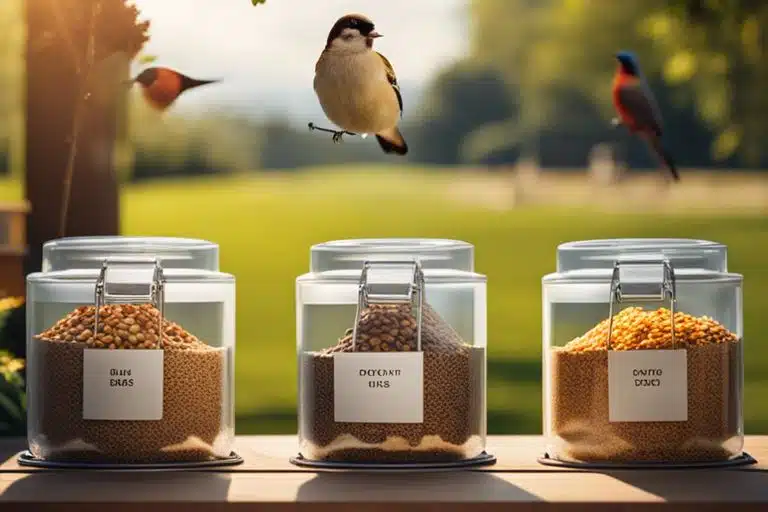Regarding storing bird food, proper techniques are important for ensuring the health of your feathered friends and saving money in the long run. Follow these 7 tips to keep bird seed fresh and free of pests. From inspecting seed bags for dust to freezing seed and suet, these methods will help you maintain a clean and safe feeding environment for your backyard birds. Learn how to store bird seed in airtight containers, clean bird feeders regularly, and watch out for potential hazards like mold and weevils. Your efforts will not only benefit the birds but also enhance your bird watching experience.

Key Takeaways:
- Store bird seed in a cool, dark place: Keeping bird seed in a cool, dark place will help prolong its freshness.
- Use an airtight container: Storing bird seed in an airtight container will help keep out pests and maintain freshness.
- Clean bird feeders often: Regularly cleaning bird feeders with soap and water helps prevent seed spoilage and keeps birds healthy.
Types of Bird Food: A Comprehensive Guide
Any bird enthusiast knows that different types of bird food cater to the diverse preferences and dietary needs of our feathered friends. From sunflower seeds to suet cakes, each variety serves a specific purpose in attracting and nourishing local bird species. Perceiving the distinctions between these types can help you create a well-rounded feeding station that appeals to a wide range of birds.
| Sunflower Seeds | High in fat and protein, attracts a variety of bird species |
| Suet Cakes | Rich in calories, great for high-energy birds like woodpeckers |
| Thistle Seed | Popular choice for finches, rich in oil content |
| Cracked Corn | Provides carbohydrates, favored by ground-feeding birds |
| Mealworms | Protein-packed, ideal for insect-eating birds like bluebirds |
Understanding Different Bird Food Varieties
An assortment of bird food varieties exists to cater to the diverse tastes and dietary needs of local avian species. From seeds to suet, each type offers unique advantages and benefits that can provide important nutrition for birds visiting your feeders.
Choosing the Right Type for Your Local Birds
Bird enthusiasts must select the appropriate type of bird food based on the local avian population’s preferences and needs. Offering a variety of options can attract a wider range of species to your feeder, fostering a diverse and vibrant bird community in your backyard.
Right choices in bird food selection can make a significant difference in the number and variety of birds visiting your feeders. Providing a mix of high-energy foods like suet cakes alongside seed varieties can cater to different bird species’ specific dietary requirements, ensuring a healthy and thriving bird population in your backyard.

Tips for Storing Bird Food Effectively
Many bird enthusiasts know the importance of properly storing bird food to keep their feathered friends healthy and happy. By following a few simple tips, you can ensure that your bird food stays fresh and free from mold, pests, and other contaminants. Here are the key strategies for effective bird food storage:
Selecting the Best Containers for Storage
Clearly, selecting the right containers for storing bird food is crucial. Airtight containers are imperative to keep out moisture and pests, ensuring the food remains fresh for longer periods. Look for containers made of durable materials such as plastic or metal with tight-fitting lids to prevent any unwanted intruders from accessing the bird food.
Ideal Conditions: Temperature and Humidity Factors
Many bird species thrive on fresh, high-quality food, so it’s crucial to store bird food in cool, dark places to maintain its nutritional value. Monitoring the temperature and humidity levels in your storage area is also important to prevent spoilage and contamination of the bird food. Knowing the ideal conditions for storing bird food can make a significant difference in preserving its freshness and quality over time.
Tips: When storing bird food, keep these factors in mind to ensure the best storage conditions for your feathered friends.
- Store bird food in cool, dark places away from sunlight and heat sources.
- Monitor temperature and humidity levels to prevent spoilage and contamination.
- Choose airtight containers made of durable materials to keep out moisture and pests.
- Regularly inspect and clean storage containers to maintain freshness.
Containers and storage conditions play a vital role in maintaining the quality and freshness of bird food. By selecting the right containers and creating ideal storage conditions, you can ensure that your feathered friends receive nutritious and safe food to keep them healthy and happy.
Step-by-Step Guide to Organizing Your Bird Food Supply
All bird lovers want to make sure their feathered friends have access to fresh and healthy food. Properly organizing your bird food supply is key to achieving this goal. Here is a step-by-step guide to help you keep your bird food storage in order and ensure your birds are always well-fed.
Keeping Food Fresh and Pest-Free
Any bird food stored improperly can quickly go bad and attract pests. To keep your bird food fresh and pest-free, store it in airtight containers in a cool, dark place. Regularly check for signs of mold or insects, and clean your containers and feeders to prevent contamination.
Rotation Practices to Ensure Freshness
There’s a simple rule to follow when it comes to bird food: first in, first out. Rotate your bird food supply regularly to ensure older food gets used first. This practice helps maintain freshness and prevents food from going bad before it’s used.
Organizing your bird food supply with proper rotation practices is necessary to maintain the quality of the food you provide to your feathered friends. By following these steps, you can ensure that your birds always have access to fresh and healthy food.
Factors to Consider When Storing Bird Food
After purchasing bird food, it is important to consider proper storage to maintain its freshness and quality. Here are some key factors to keep in mind:
- Choose a cool and dark storage location.
- Use airtight containers to prevent pests and moisture.
- Freeze seed and suet for longer shelf life.
- Clean bird feeders regularly to prevent contamination.
Shelf Life of Different Bird Foods
Storing bird food effectively is crucial for preserving its quality over time. Different types of bird food have varying shelf lives, with seeds lasting up to one year when frozen and suet cakes remaining fresh for up to a year in the freezer.
Signs of Spoilage and Contamination to Look For
Clearly identifying signs of spoilage and contamination in bird food is vital to ensuring the health of our feathered friends. Another crucial aspect is to inspect the food for any strange odors, mold growth, or insect infestations. If the food appears off or unappealing, it is best to discard it and replace it with fresh food. Knowing when to spot potential issues can prevent birds from consuming harmful or spoiled food.
Pros and Cons of Various Storage Methods
| Storage Method | Pros and Cons |
| Plastic Bins | – Easy to find and purchase – Lightweight and easy to transport – Can be prone to cracking or breaking in extreme temperatures – Not as rodent-proof as metal containers |
| Metal Containers | – Durable and long-lasting – Rodent-proof – Can be heavier and less portable – More expensive than plastic bins |
Plastic Bins vs. Metal Containers
Containers Plastic bins are convenient and affordable options for storing bird seed. They are easily accessible and suitable for indoor storage. However, they may not be the best choice for outdoor use as they can crack or break in extreme temperatures. On the other hand, metal containers are durable and rodent-proof, making them ideal for long-term outdoor storage. While they may be more expensive, their longevity makes them a worthwhile investment.
Outdoor vs. Indoor Storage Solutions
With regards to outdoor vs. indoor storage solutions, it is necessary to consider the conditions your bird food will be exposed to. Outdoor storage is beneficial for easy access and keeping your living space tidy. However, it is crucial to ensure that the storage containers are weatherproof and secure to prevent pests and moisture damage. Indoor storage, on the other hand, offers better protection from extreme temperatures and pests but may be limited by space constraints.
The Importance of Properly Storing Bird Seed
The key to keeping your feathered friends healthy and happy is through proper storage of bird seed. By following these tips, you can ensure that the food stays fresh and free from mold, insects, and rodents. From inspecting seed bags for dust to freezing seed for longer life, each step plays a crucial role in maintaining the quality of the food you provide for the birds. By storing bird seed in a cool, dark place, using airtight containers, and cleaning feeders frequently, you can create a welcoming environment for your backyard visitors. Remember to always be mindful of the condition of the seed and take the necessary steps to keep it fresh and enticing for your avian companions.
FAQ
Q: Why is it important to store bird food properly?
A: Proper storage of bird food helps keep it fresh, free of mold, and prevents infestations by rodents and insects, ensuring the health of the birds in your backyard.
Q: How can I store bird food to keep it fresh?
A: Store bird food in a cool, dark place in an airtight container to prevent spoilage. Freezing seed and suet can also extend their shelf life.
Q: How often should I clean bird feeders?
A: Clean bird feeders at least once with every new season using soap and water to prevent spoilage. Hummingbird feeders should be cleaned more often, every week during peak season, using a mixture of water and bleach.
As a bird enthusiast with a passion for sharing the wonders of our feathered friends. As a writer and nature lover, I'm thrilled to connect with fellow bird buffs and inspire others to take flight into the fascinating world of birds. Let's wing it together!


